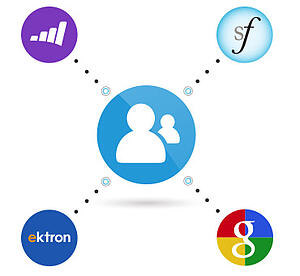Learn about some of the tools and improvements that developers can utilize in the latest update of the Ektron CMS platform.
The technology that websites use is continually evolving and improving, and this is especially true in the world of CMS development. As developers use the tools provided by CMS platforms and the improvements added with each software update, we learn how to incorporate them into our development processes and build websites that provide the best experiences for their users.
The Ektron CMS is a great example of a platform that has continually made improvements that allow developers to create sites that function optimally, integrate with other systems, and provide an intuitive experience for both end users and content editors. Ektron 9, the latest release of the CMS software, has been out for about a year now, and as developers continue to use it, we’ve found that it has brought some functionalities that are essential for the work that we do. Here are some examples of how Ektron’s updates have improved our development processes and allowed us to build better websites:
Persona Management
 As Inbound Marketing continues to grow and become the primary method of attracting website traffic and building an audience, the importance of defining buyer personas is evident. Ektron’s Persona Management suite allows site editors to utilize these personas, and developers can use the Digital Experience Hub (DxH) to integrate Ektron with external systems such as a MAP or CRM. Combining these systems allows for the creation of targeted content, customizing each individual user’s experience on a website to provide them with the information that is relevant to them.
As Inbound Marketing continues to grow and become the primary method of attracting website traffic and building an audience, the importance of defining buyer personas is evident. Ektron’s Persona Management suite allows site editors to utilize these personas, and developers can use the Digital Experience Hub (DxH) to integrate Ektron with external systems such as a MAP or CRM. Combining these systems allows for the creation of targeted content, customizing each individual user’s experience on a website to provide them with the information that is relevant to them.
Solr Search
 Version 9 of Ektron includes full support of Apache Solr as a search service. Using Solr to power the searches that users use to find content on a website is easy to implement and features many robust options that were not previously available, including faceted search. Faceted search allows users to narrow their searches, which is especially useful in eCommerce sites, since they can limit the items they are searching for to certain departments, sizes, price ranges, etc.
Version 9 of Ektron includes full support of Apache Solr as a search service. Using Solr to power the searches that users use to find content on a website is easy to implement and features many robust options that were not previously available, including faceted search. Faceted search allows users to narrow their searches, which is especially useful in eCommerce sites, since they can limit the items they are searching for to certain departments, sizes, price ranges, etc.
eCommerce APIs
The addition of eCommerce APIs to Ektron’s Framework APIs provided some much-needed functionality for developers who are creating eCommerce sites. The combination of these tools provided a much better interface for developers to work with, allowing the content and commerce frameworks to function in the same way. The structure of the APIs has also been greatly improved, making functions like the addition of products to the CMS work much better.
Adaptive Images
The size of the images that users have to download when accessing a website is one factor that can greatly affect page performance, especially for people who are using mobile devices. Ektron now automatically resizes images to match different screen sizes, providing a better experience for users across every type of device.
At Diagram, we’ve taken this one step further by creating custom code to resize pictures dynamically, using Picturefill alongside Ektron’s Adaptive Images to allow users to upload a single image without having to worry about what size image should be used with which device. This is a great example of how developers can utilize Ektron’s functionalities and their own expertise to create the best tools for a site’s users.
eSync
Ektron’s eSync product provides a great way to synchronize content, assets, and templates between different environments, and Ektron 9 adds even more functionality for developers, allowing them to tap into events and execute code at certain times. For instance, when a sync has completed, content that has been pushed to the production server won’t usually appear until the cache has expired, but developers can now execute code that clears the cache as soon as a sync is finished, allowing this new content to be immediately visible.
Advanced Workflow
Workflows can be used to define the approvals that are necessary before publishing content, but until now, the approvals process was fairly basic, following a linear chain of approvals. With the latest release, Ektron’s Advanced Workflow provides greater functionality, allowing for things like fallback approvals. In this case, if a piece of content is stuck waiting for approval because one person in the chain is not available, a fallback person can be specified, and if content is not approved within a specified time period, an approval request can be sent to the fallback person, keeping content from being stuck waiting for approval in order to be published. Developers can use these new tools to build their own workflows and create their own approval processes; this is another example of the increased functionality that is now available.
As Ektron continues to grow, it’s exciting to see the new tools that are available for developers to use in our efforts to create the best online experiences. These are just a few of the improvements that Ektron has implemented, and they’re continuing to move ahead with products like their Content Marketing Platform that allow developers to build websites that best meet their users’ needs. Do you have any questions about how you can use Ektron’s tools to create the ideal website for your company? Please contact us to speak to a Solutions Engineer, or feel free to leave a comment below.
Related Posts

Navigating an Optimizely CMS 12 Upgrade
Learn why an Optimizely CMS 12 upgrade needs detailed planning, efficient resource allocation, and an understanding of your organization's capabilities.
CMS Cloud Mastery: Overcoming Migration Challenges (Webinar)
Umbraco and Diagram have teamed up for a webinar on April 24th, 2024 at 12pm (ET) to discuss how to overcome cloud-based migration challenges. Register now.
Results Matter.
We design creative digital solutions that grow your business, strengthen your brand and engage your audience. Our team blends creativity with insights, analytics and technology to deliver beauty, function, accessibility and most of all, ROI. Do you have a project you want to discuss?
Like what you read?
Subscribe to our blog "Diagram Views" for the latest trends in web design, inbound marketing and mobile strategy.

